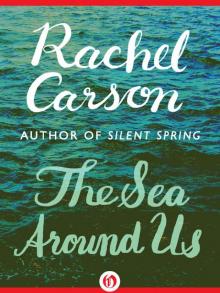- Home
- Rachel Carson
Lost Woods: The Discovered Writing of Rachel Carson Page 2
Lost Woods: The Discovered Writing of Rachel Carson Read online
Page 2
To sense this world of waters known to the creatures of the sea we must shed our human perceptions of length and breadth and time and place, and enter vicariously into a universe of all-pervading water. For to the sea’s children nothing is so important as the fluidity of their world. It is water that they breathe; water that brings them food; water through which they see, by filtered sunshine from which first the red rays, then the greens, and finally the purples have been strained; water through which they sense vibrations equivalent to sound. And indeed it is nothing more or less than sea water, in all its varying conditions of temperature, saltiness, and pressure, that forms the invisible barriers that confine each marine type within a special zone of life – one to the shore line, another to some submarine chasm on the far slopes of the continental shelf, and yet another, perhaps, to an imperceptibly defined stratum at mid-depths of ocean.
There are comparatively few living things whose shifting pattern of life embraces both land and sea. Such are the creatures of the tide pools among the rocks and of the mud flats sloping away from dune and beach grass to the water’s edge. Between low water and the flotsam and jetsam of the high-tide mark, land and sea wage a never-ending conflict for possession.
As on land the coming of night brings a change over the face of field and forest, sending some wild things into the safe retreat of their burrows and bringing others forth to prowl and forage, so at ebb tide the creatures of the waters largely disappear from sight, and in their place come marauders from the land to search the tide pools and to probe the sands for the silent, waiting fauna of the shore.
Twice between succeeding dawns, as the waters abandon pursuit of the beckoning moon and fall back, foot by foot, periwinkle and starfish and crab are cast upon the mercy of the sands. Every heap of brine-drenched seaweed, every pool forgotten by the retreating sea in recess of sand or rock, offers sanctuary from sun and biting sand.
In the tide pools, seas in miniature, sponges of the simpler kinds encrust the rocks, each hungrily drawing in through its myriad mouths the nutriment-laden water. Starfishes and sea anemones are common dwellers in such rock-girt pools. Shell-less cousins of the snail, the naked sea slugs are spots of brilliant rose and bronze, spreading arborescent gills to the waters, while the tube worms, architects of the tide pools, fashion their conical dwellings of sand grains, cemented one against another in glistening mosaic.
On the sands the clams burrow down in search of coolness and moisture, and oysters close their all-excluding shells and wait for the return of the water. Crabs crowd into damp rock caverns, where periwinkles cling to the walls. Colonies of gnome-like shrimps find refuge under dripping strands of brown, leathery weed heaped on the beach.
Hard upon the retreating sea press invaders from the land. Shore birds patter along the beach by day, and legions of the ghost crab shuffle across the damp sands by night. Chief, perhaps, among the plunderers is man, probing the soft mud flats and dipping his nets into the shallow waters.
At last comes a tentative ripple, then another, and finally the full, surging sweep of the incoming tide. The folk of the pools awake – clams stir in the mud. Barnacles open their shells and begin a rhythmic sifting of the waters. One by one, brilliant-hued flowers blossom in the shallow water as tube worms extend cautious tentacles.
The ocean is a place of paradoxes. It is the home of the great white shark, two-thousand-pound killer of the seas, and of the hundred-foot blue whale, the largest animal that ever lived. It is also the home of living things so small that your two hands might scoop up as many of them as there are stars in the Milky Way. And it is because of the flowering of astronomical numbers of these diminutive plants, known as diatoms, that the surface waters of the ocean are in reality boundless pastures. Every marine animal, from the smallest to the sharks and whales, is ultimately dependent for its food upon these microscopic entities of the vegetable life of the ocean. Within their fragile walls, the sea performs a vital alchemy that utilizes the sterile chemical elements dissolved in the water and welds them with the torch of sunlight into the stuff of life. Only through this little-understood synthesis of proteins, fats, and carbohydrates by myriad plant “producers” is the mineral wealth of the sea made available to the animal “consumers” that browse as they float with the currents. Drifting endlessly, midway between the sea of air above and the depths of the abyss below, these strange creatures and the marine inflorescence that sustains them are called “plankton” – the wanderers.
Many of the fishes, as well as the bottom-dwelling mollusks and worms and starfish, begin life as temporary members of this roving company, for the ocean cradles their young in its surface waters. The sea is not a solicitous foster mother. The delicate eggs and fragile larvæ are buffeted by storms raging across the open ocean and preyed upon by diminutive monsters, the hungry glassworms and comb jellies of the plankton.
These ocean pastures are also the domain of vast shoals of adult fishes: herring, anchovy, menhaden, and mackerel, feeding upon the animals of the plankton and in their turn preyed upon; for here the dogfish hunt in packs, and the ravenous bluefish, like roving buccaneers, take their booty where they find it.
Dropping downward a scant hundred feet to the white sand beneath, an undersea traveler would discover a land where the noonday sun is swathed in twilight blues and purples, and where the blackness of midnight is eerily aglow with the cold phosphorescence of living things. Dwelling among the crepuscular shadows of the ocean floor are creatures whose terrestrial counterparts are drab and commonplace, but which are themselves invested with delicate beauty by the sea. Crystal cones form the shells of pteropods or winged snails that drift downward from the surface to these dim regions by day; and the translucent spires of lovely Ianthina are tinged with Tyrian purple.
Other creatures of the sea’s bottom may be fantastic rather than beautiful. Spine-studded urchins, like rotund hedgehogs of the sea, tumble over the sands, where mollusks lie with slightly opened shells, busily straining the water for débris. Life flows on monotonously for these passive sifters of the currents, who move little or not at all from year to year. Among the rock ledges, eels and cunners forage greedily, while the lobster feels his way with nimble wariness through the perpetual twilight.
Farther out on the continental shelf, the ocean floor is scarred with deep ravines, perhaps the valleys of drowned rivers, and dotted with undersea plateaus. Hosts of fish graze on these submerged islands, which are richly carpeted with sluggish or sessile forms of life. Chief among the ground fish are haddock, cods, flounders and their mightier relative, the halibut. From these and shallower waters man, the predator, exacts a yearly tribute of nearly thirty billion pounds of fish.
If the underwater traveler might continue to explore the ocean floor, he would traverse miles of level prairie lands; he would ascend the sloping sides of hills; and he would skirt deep and ragged crevasses yawning suddenly at his feet. Through the gathering darkness, he would come at last to the edge of the continental shelf. The ceiling of the ocean would lie a hundred fathoms above him, and his feet would rest upon the brink of a slope that drops precipitously another mile, and then descends more gently into an inky void that is the abyss.
What human mind can visualize conditions in the uttermost depths of the ocean? Increasing with every foot of depth, enormous pressures reach, three thousand fathoms down, the inconceivable magnitude of three tons to every square inch of surface. In these silent deeps a glacial cold prevails, a bleak iciness which never varies, summer or winter, years melting into centuries, and centuries into ages of geologic time. There, too, darkness reigns – the blackness of primeval night in which the ocean came into being, unbroken, through æons of succeeding time, by the gray light of dawn.
It is easy to understand why early students of the ocean believed these regions were devoid of life, but strange creatures have now been dredged from the depths to bear mute and fragmentary testimony concerning life in the abyss.
The “monsters”
of the deep sea are small, voracious fishes with gaping, tooth-studded jaws, some with sensitive feelers serving the function of eyes, others bearing luminous torches or lures to search out or entice their living prey. Through the night of the abyss, the flickering lights of these foragers move to and fro. Many of the sessile bottom dwellers glow with a strange radiance suffusing the entire body, while other swimming creatures may have tiny, glittering lights picked out in rows and patterns. The deep-sea prawn and the abyssal cuttlefish eject a luminous cloud, and under cover of this pillar of fire escape from their enemies.
Monotones of red and brown and lustreless black are the prevailing colors in the deep sea, allowing the wearers to reflect the minimum of the phosphorescent gleams, and to blend into the safe obscurity of the surrounding gloom.
On the muddy bottom of the abyss, treacherous oozes threaten to engulf small scavengers as they busily sift the débris for food. Crabs and prawns pick their way over the yielding mud on stilt-like legs; sea spiders creep over sponges raised on delicate stalks above the slime.
Because the last vestige of plant life was left behind in the shallow zone penetrated by the rays of the sun, the inhabitants of these depths contrast strangely with the self-supporting assemblage of the surface waters. Preying one upon another, the abyssal creatures are ultimately dependent upon the slow rain of dead plants and animals from above. Every living thing of the ocean, plant and animal alike, returns to the water at the end of its own life span the materials that had been temporarily assembled to form its body. So there descends into the depths a gentle, never-ending rain of the disintegrating particles of what once were living creatures of the sunlit surface waters, or of those twilight regions beneath.
Here in the sea mingle elements which, in their long and amazing history, have lent life and strength and beauty to a bewildering variety of living creatures. Ions of calcium, now free in the water, were borrowed years ago from the sea to form part of the protective armor of a mollusk, returned to the main reservoir when their temporary owner had ceased to have need of them, and later incorporated into the delicate statuary of a coral reef. Here are atoms of silica, once imprisoned in a layer of flint in subterranean darkness; later, within the fragile shell of a diatom, tossed by waves and warmed by the sun; and again entering into the exquisite structure of a radiolarian shell, that miracle of ephemeral beauty that might be the work of a fairy glass-blower with a snowflake as his pattern.
Except for precipitous slopes and regions swept bare by submarine currents, the ocean floor is covered with primeval oozes in which there have been accumulating for æons deposits of varied origin; earth-born materials freighted seaward by rivers or worn from the shores of continents by the ceaseless grinding of waves; volcanic dust transported long distances by wind, floating lightly on the surface and eventually sinking into the depths to mingle with the products of no less mighty eruptions of submarine volcanoes; spherules of iron and nickel from interstellar space; and substances of organic origin – the silicious skeletons of Radiolaria and the frustules of diatoms, the limey remains of algæ and corals, and the shells of minute Foraminifera and delicate pelagic snails.
While the bottoms near the shore are covered with detritus from the land, the remains of the floating and swimming creatures of the sea prevail in the deep waters of the open ocean. Beneath tropical seas, in depths of 1000 to 1500 fathoms, calcareous oozes cover nearly a third of the ocean floor; while the colder waters of the temperate and polar regions release to the underlying bottom the silicious remains of diatoms and Radiolaria. In the red clay that carpets the great deeps at 3000 fathoms or more, such delicate skeletons are extremely rare. Among the few organic remains not dissolved before they reach these cold and silent depths are the ear bones of whales and the teeth of sharks.
Thus we see the parts of the plan fall into place: the water receiving from earth and air the simple materials, storing them up until the gathering energy of the spring sun wakens the sleeping plants to a burst of dynamic activity, hungry swarms of plank-tonic animals growing and multiplying upon the abundant plants, and themselves falling prey to the shoals of fish; all, in the end, to be redissolved into their component substances when the inexorable laws of the sea demand it. Individual elements are lost to view, only to reappear again and again in different incarnations in a kind of material immortality. Kindred forces to those which, in some period inconceivably remote, gave birth to that primeval bit of protoplasm tossing on the ancient seas continue their mighty and incomprehensible work. Against this cosmic background the life span of a particular plant or animal appears, not as a drama complete in itself, but only as a brief interlude in a panorama of endless change.
2
[1922]
My Favorite Recreation
RACHEL CARSON KNEW from her earliest conscious memory that she wanted to be a writer. A solitary child, she read voraciously and was particularly influenced by the children’s literary magazine St. Nicholas, which not only offered writing of exceptional literary quality, but also awarded prizes for and published children’s work. Carson submitted five stories in all and in doing so joined the company of such future literary luminaries as William Faulkner, F. Scott Fitzgerald, e.e. cummings, S. Eliot Morison, Edna St. Vincent Millay, and E. B. White, all of whom won prizes and were published in the pages of St. Nicholas.
Carson’s last story appeared when she was fifteen. She had already achieved the esteemed status of “Honor Member” of the St. Nicholas League and been paid $10 for one of them. This story about exploring the Pennsylvania hills was her first about nature and was submitted in the category of “My Favorite Recreation.” It shows something of Carson’s already acute observation of the natural world and is noteworthy for the inclusion of her favorite bird, the wood thrush.
THE CALL OF THE TRAIL on that dewy May morning was too strong to withstand. The sun was barely an hour high when Pal and I set off for a day of our favorite sport with a lunch-box, a canteen, a note-book, and a camera. Your experienced woodsman will say that we were going birds’-nesting – in the most approved fashion.
Soon our trail turned aside into deeper woodland. It wound up a gently sloping hill, carpeted with fragrant pine-needles. It was our own discovery, Pal’s and mine, and the fact gave us a thrill of exultation. It was the sort of place that awes you by its majestic silence, interrupted only by the rustling breeze and the distant tinkle of water.
Near at hand we heard the cheery “witchery, witchery,” of the Maryland yellow-throat. For half an hour we trailed him, until we came out on a sunny slope. There in some low bushes we found the nest, containing four jewel-like eggs. To the little owner’s consternation, we came close enough to snap a picture.
Countless discoveries made the day memorable: the bob-white’s nest, tightly packed with eggs, the oriole’s aërial cradle, the frame-work of sticks which the cuckoo calls a nest, and the lichen-covered home of the humming-bird.
Late in the afternoon a penetrating “Teacher! teacher! TEACHER!” reached our ears. An oven-bird! A careful search revealed his nest, a little round ball of grass, securely hidden on the ground.
The cool of approaching night settled. The wood-thrushes trilled their golden melody. The setting sun transformed the sky into a sea of blue and gold. A vesper-sparrow sang his evening lullaby. We turned slowly homeward, gloriously tired, gloriously happy!
3
[1938]
Fight for Wildlife Pushes Ahead / Chesapeake Eels Seek the Sargasso Sea
CARSON COMPLETED HER M.A. in Zoology at Johns Hopkins University in Baltimore, Maryland, in 1932. The Depression dashed her hopes of going on for a doctorate but she continued to teach part-time at the University of Maryland while she tried to find a college position. Although she thought she had forever abandoned a writing career, economic necessity, compounded by the death of her father in 1935 and her assumption of the role of head of household, forced her to return to writing.
Research for radio scripts she was w
riting for the Bureau of Fisheries served as the basis of feature articles on Maryland’s natural history which she sent to the local newspaper, the Baltimore Sun. Sunday editor Mark Watson was impressed with Carson’s lucid style and her scientific accuracy and published as many of her articles as he could, sometimes sending those he could not use to affiliated newspapers.
Much of Carson’s newspaper writing concerns the population and habitat changes of mid-Atlantic fish and wildlife and reflects the research of a thoroughly competent marine biologist. They show Carson’s already broad interest in the conservation of resources, her special interest in wildlife, her concern with the impact of human exploitation on wildlife habitats, and her fascination with the intricate processes of nature.
Carson’s interest in eels began during her summer study at the Marine Biological Laboratory at Woods Hole, Massachusetts, where she saw the ocean for the first time in the summer of 1929. Later, in a protozoology experiment at Johns Hopkins, she observed the effect changes in the salinity of sea water had on the behavior of the eel. Carson’s fascination with these beautiful and unfathomable creatures appears most significantly in Book III of Under the Sea-Wind, where the central character is Anguilla, a European eel who ends her maturation with a two-hundred-mile journey to the open sea.

 Silent Spring
Silent Spring Under the Sea Wind
Under the Sea Wind The Edge of the Sea
The Edge of the Sea The Sea Around Us
The Sea Around Us Lost Woods: The Discovered Writing of Rachel Carson
Lost Woods: The Discovered Writing of Rachel Carson Lost Woods
Lost Woods